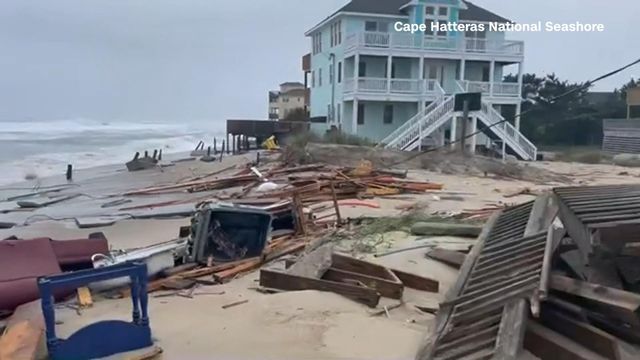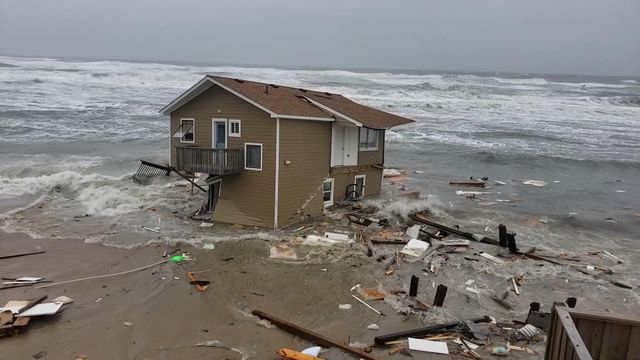Some Outer Banks beaches shrinking by more than 14 feet per year
Federal officials say that sea levels in the area have risen roughly 1 inch every five years, with climate change being one key reason. State officials say that some Outer Banks beaches are shrinking more than 14 feet per year in some areas.
Posted — UpdatedRODANTHE, N.C. — Like millions of other people this past week, Hien Pham marveled at the online video of the two-story, pea-green beach house as it collapsed into a rising sea, left to bob in the agitated surf like a giant cork.
This particular giant cork, formerly at 24265 Ocean Drive, was Pham’s. He had purchased the four-bedroom place in November 2020 for $275,000.
“It’s definitely a feeling that you can’t explain,” said Pham, 30, a Knoxville, Tennessee, real estate agent. “Just to see something that once was there, and it’s not there anymore.”
The feeling, he added, “is pretty empty.”
Three prime beachfront lots are now empty on Ocean Drive, a small stretch of a charmingly scruffy Outer Banks subdivision called Trade Winds Beaches that has, to the chagrin of its property owners, become a sort of poster neighborhood for sea-level rise — particularly since the video of Pham’s house, which collapsed Tuesday, was shared widely on social media. The once-generous stretch of beach in front of the houses has largely vanished in recent months, leaving them vulnerable to the destructive power of the Atlantic Ocean.
It was Feb. 9 when the first house on the street floated away. A second house, a girthy two-story place with double wraparound porches owned by Ralph Patricelli of California, was claimed by the ocean just hours before Pham’s.
“I talked to a contractor who is helping us with the cleanup; he said there is nothing left of our house,” Patricelli said. “We don’t know where it’s gone. But it’s just completely gone.”
The gradual nature of sea-level rise means that for many coastal communities, it can feel like a distant threat. That is not the case on North Carolina’s Outer Banks, the delicate chain of barrier islands fronting the Atlantic. Federal officials say that sea levels in the area have risen roughly 1 inch every five years, with climate change being one key reason. State officials say that some Outer Banks beaches are shrinking more than 14 feet per year in some areas.
“The water’s already high and the waves are coming that much further inland, eating away at sand in a way that it wouldn’t if the seas were lower,” said William Sweet, an expert on sea-level rise at the National Oceanic and Atmospheric Administration.
Experts and locals note that on places like Hatteras Island, a thin strip of land where Trade Winds Beaches is one of numerous imperiled neighborhoods, beach erosion is a natural and inevitable process. Barrier islands get battered by storms on the ocean side, with the sands shifting westward, building up on the bay side.
David Hallac, superintendent of the National Parks of Eastern North Carolina, said that rising seas, and the increased frequency and intensity of storms, are likely intensifying the erosion on Ocean Drive, which abuts the Hatteras Island National Seashore. Patricelli, who was never a climate-change doubter, said the disappearance of his house brought the issue out of the realm of abstraction.
“I think I have been naive that it’s not going to affect me on the level that it just did,” he said. “Having experienced this, I have a whole new level, in my head, of how severe climate change is.”
The last two houses were destroyed amid a multiday nor’easter that pushed sand and wind onto North Carolina Highway 12, closing the essential two-lane route onto Hatteras Island for more than a day. On Thursday, Ocean Drive was a post-storm mess. The pavement was buried under several feet of sand, as if in a snowstorm. Splintered wood and other debris from the two houses were scattered around, spreading southward along the coast. Beach rentals with happy names (“Kai Surf House”) were mostly unoccupied. TV news crews trudged around. Mark Gray, a worker with a cleanup company, was scraping remnants of Patricelli’s house with an excavator.
“Mother Nature’s pissed off,” he said, “or something.”
Hallac stood in front of the place where Patricelli’s house used to be, wrinkling his nose as the stench from the broken septic system wafted toward him. None of this, he said, was surprising. Around the time the first house collapsed, he said, officials in Dare County, North Carolina, informed his office that eight homes on the street had been ruled unsafe for habitation.
“So I reached out to homeowners and said, ‘Hey, can you move your house, or remove it?’” Hallac said.
Both these options proved problematic for Ocean Drive homeowners in ways that many more property owners may experience in the next 30 years, a time period in which sea levels along U.S. coastlines are likely to rise by 1 foot, on average, resulting in more coastal flooding, according to a multiagency federal report released in February. Robert Coleman, the owner of the house that fell in February, had considered moving or tearing down the place. He discovered that insurance companies would pay him for the house if it was destroyed by the ocean, but not if he tore it down himself. Coleman said he got in touch with a company that would move his house 35 feet inland, at a cost of $185,000. It was too much for him to stomach. So the tide took it away.
“I got a call from the park service saying, ‘Your house just fell. Come get it cleaned up,’” Coleman said. The debris washed down the coast for miles. The total cleanup, he said, cost him $57,000.
Patricelli said that two of his neighbors have moved their houses inland. But he said that only seemed to be buying a little time. “Moving the house doesn’t mean you’re not going to have problems,” he said. “We can see what the ocean can do.”
Elsewhere on Hatteras Island, some communities have embraced a solution called beach nourishment, which involves replenishing the beach with sand pumped from offshore. But that is expensive work, and Danny Couch, a member of the Dare County Commission, said he was skeptical that he could convince the park service that such a project was necessary to protect vital infrastructure, in part because a new elevated road will soon open up next to a flood-prone stretch of Highway 12 near Ocean Drive.
For now, Patricelli’s dream of having a rental investment property — one where his bicoastal family could also gather and make memories — is lost. But some beachfront houses are still attracting visitors. Just up the beach from Patricelli’s lot, Stephanie Weyer, a truck dispatcher from Pennsylvania, was enjoying a vacation with her family as best as she could, given the weather and the drama. She said she planned to come back to the same house next year — but 20 years on, she wondered if the neighborhood would be gone. A few houses away, Matt Storey was pacing on the outdoor deck of the beachfront home he had bought in November and christened “Mermaid’s Dream.” He estimated there were roughly 70 feet of sand between the house and the beach when he closed on the property. On Thursday, the waves were lapping by the pilings of the house.
Storey, who lives in Raleigh, North Carolina, said that he felt somewhat confident buying the house, particularly because it had been moved back from the ocean in 2018 at a cost of $200,000. He owns another place nearby, and while he expected potential erosion problems eventually, he did not anticipate them coming so fast.
For now, he said, he planned to keep renting the place. But he said he worried about losing his investment.
“We’re stressed out,” he said. “The worst thing that can happen is I can’t sell it, I can’t move it, I can’t get rid of it, and I can’t rent it.”
Storey said his “nuclear option” was moving to Ocean Drive and living in his house full time, but that, too, came with obvious risks. “I don’t have a plan,” he said. “My plan is to ride it out.”
Related Topics
Copyright 2024 New York Times News Service. All rights reserved.






